The Press Room highlights computational astronomy work around the UC-HiPACC consortium; the wording of the short summaries on this page is based on wording in the individual releases or on the summaries on the press release page of the original source. Press releases below appear in reverse chronological order (most recent first); they can also be displayed by UC campus or DOE lab by clicking on the desired venue at the bottom of the left-hand column.
October 21, 2014 — POLARBEAR seeks cosmic answers in microwave polarization
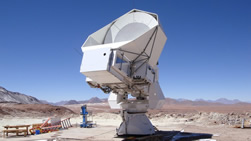
The Huan Tran Telescope in the Atacama Desert of Chile. The POLARBEAR microwave bolometers are mounted on the telescope to study the polarization (twisting) of light from just 380,000 years after the Big Bang to determine when dark energy, the mysterious force accelerating the expansion of the universe, began to dominate and overwhelm gravity.
October 2, 2014 — Funding for big-data projects in ecology, astronomy & microscopy
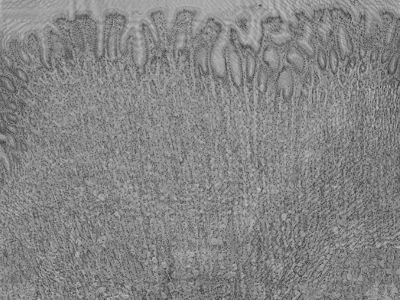
New microscopy tools: Wide field-of-view, high resolution image of dog cardiac tissue section taken by the Computational Imaging Lab.
May 21, 2014 — Search for extraterrestrial intelligence gets hearing on Hill
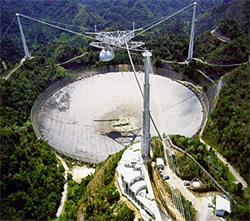
The Arecibo radio telescope in Puerto Rico
May 1, 2014 — Hubble astronomers check the prescription of a cosmic lens

The heart of a vast cluster of galaxies called MACS J1720+35 is shown in this image, taken in visible and near-infrared light by NASA’s Hubble Space Telescope. The galaxy cluster is so massive that its gravity distorts, brightens, and magnifies light from more-distant objects behind it, an effect called gravitational lensing. Credit: NASA and ESA
March 25, 2014 — Lick’s Automated Planet Finder: First robotic telescope for planet hunters
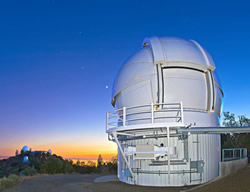
The Automated Planet Finder (APF) is the newest telescope at UC's Lick Observatory on Mt. Hamilton. (Photo by Laurie Hatch)
March 18, 2014 — Fierce solar magnetic storm barely missed Earth in 2012
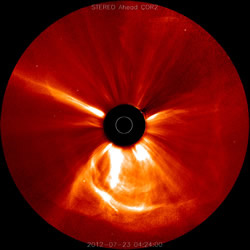
Video in UCB press release shows a coronal mass ejection (CME) on the sun from July 22, 2012, at 10:00 p.m. EDT until 2 a.m. on July 23, as captured by NASA’s Solar Terrestrial Relations Observatory-Ahead (STEREO A). Because the CME headed in STEREO A’s direction, it appears like a giant halo around the sun.
February 27, 2014 — Closest, brightest supernova in decades is also a little weird
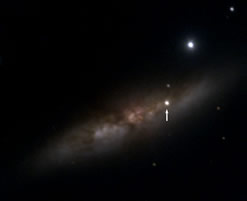
A color composite of SN 2014J, located in the “cigar galaxy” M82, 11.4 million light years away, made from KAIT images obtained through several different filters. The supernova is marked with an arrow. Other round objects are relatively nearby stars in our own Milky Way Galaxy. (Image by W. Zheng and A. Filippenko, UC Berkeley)
19 February 2014 — NuSTAR takes first peek into core of supernova
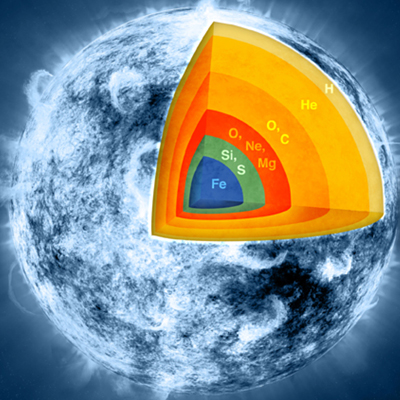
Stars fuse hydrogen (H) and helium (He) into heavier elements to produce energy, but once the reactions reach iron (Fe), fusion stops and the star implodes, creating a compact object – a neutron star or black hole – and blowing off the star’s outer layers in a supernova explosion. The explosion seeds the galaxy with elements like carbon (C) and oxygen (O) essential to life. NASA image.
Read full UCB press release
January 6, 2014 — Galaxy teems with sub-Neptune planets that are missing in our own solar system
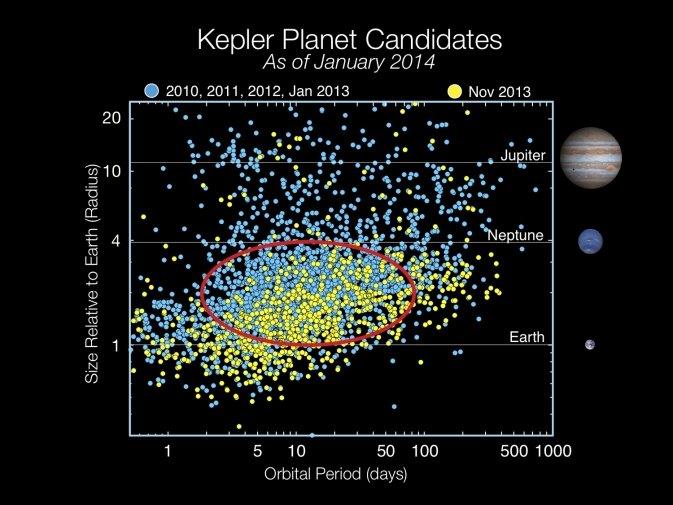
More than three-quarters of the planet candidates discovered by NASA's Kepler spacecraft have sizes ranging from that of Earth to that of Neptune, which is nearly four times as big as Earth. Such planets dominate the galactic census but are not represented in our own solar system. (Image: NASA Ames)
View full NASA Ames press release
December 18, 2013 — Powerful ancient explosions explain new class of supernovas
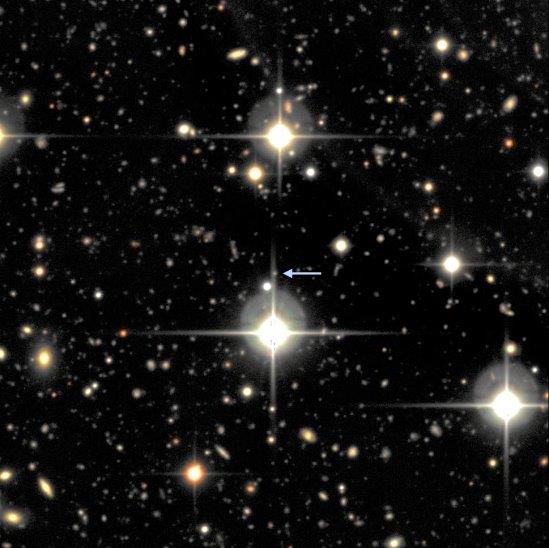
A small portion of one of the fields from the Supernova Legacy Survey showing SNLS-06D4eu and its host galaxy (arrow).
Read full UC Berkeley press release
December 16, 2013 — Novel instrument probes close binary stars, may soon image exoplanets
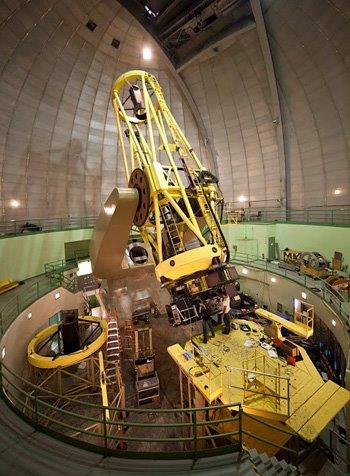
Franck Marchis and colleague mount the FIRST instrument on the Shane 3-meter telescope at Lick Observatory.
View full UC Berkeley press release
December 13, 2013 — Daniel Kasen among four young professors awarded Presidential early-career awards
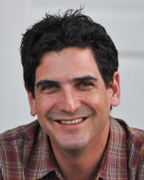
View full White House press release
December 12, 2013 — Big turnout for launch of big-data center
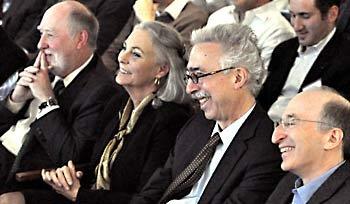
On hand to celebrate (left to right): Vice Chancellor for Research Graham Fleming, Moore Foundation’s Vicki Chandler, Chancellor Dirks and BIDS director Saul Perlmutter (Peg Skorpinski photo)
View full UC Berkeley press release
November 4, 2013 — Astronomers answer key question: How common are habitable planets?
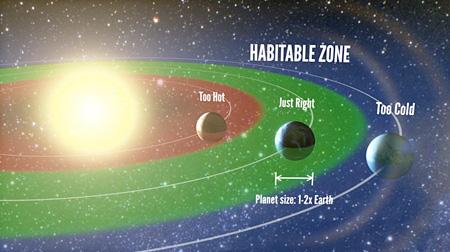
UCB and UH authors find that 22% of Sun-like stars harbor a planet between one and two times the size of Earth in the habitable zone of orbits where liquid water can form on the surface of a planet.
View full UCB press release.
August 23, 2013 — A brighter method for measuring the surface gravity of distant stars
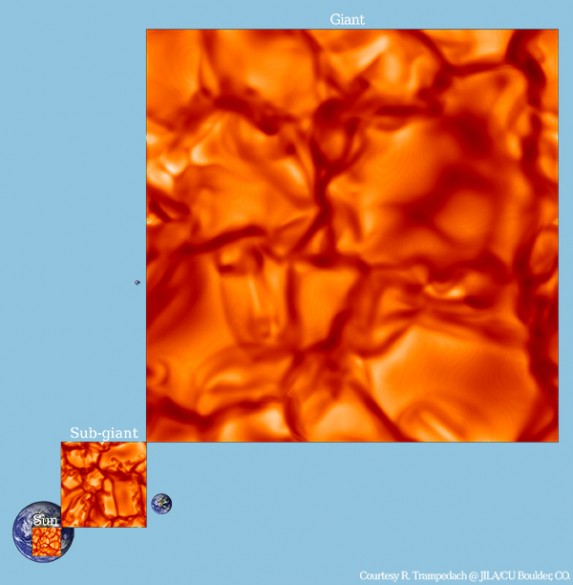
Simulations of granulation patterns on the surface of the Sun, sub-giant and giant stars.
view full Vanderbilt Press Release
August 20, 2013 — New theory points to ‘zombie vortices’ as key step in star formation
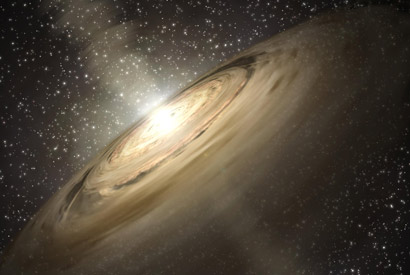
Illustration of a protoplanetary disk based upon observations from the Keck II telescope.
view full UCB Press Release
July 29, 2013 — Quest to test Einstein’s speed limit
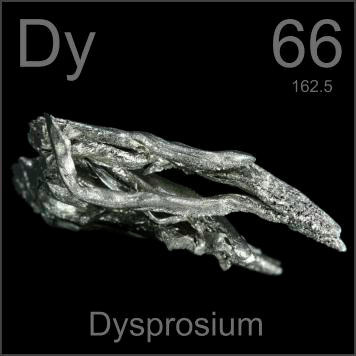
Dysprosium, a rare-earth element used in hard disk coatings, has an unusual electronic structure ideally suited to experiments like this.
view full UCB Press Release
July 8, 2013 — Saul Perlmutter: 'Science is about figuring out your mistakes'
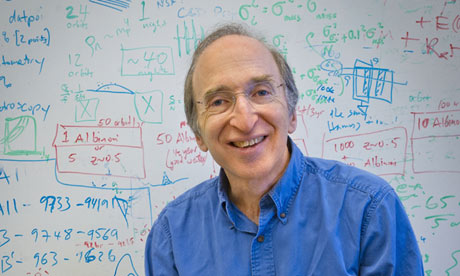
Saul Perlmutter in his office at the Lawrence Berkeley National Laboratory in California.
view full The Guardian Press Release
April 16, 2013 — UCB chosen to build NASA’s next weather satellite
The ICON satellite will orbit Earth at a 27 degree angle to the equator, pointing its MIGHTI imager and far and extreme ultraviolet sensors at ionospheric storms as on-board instruments measure the flow of charged-particles (guided by the arched magnetic field shown with blue lines) at the position of the satellite.
view full UCB Press Release
March 27, 2013 — Professor Enlists Android Phones in Search for Black Holes

Berkeley computer scientist David Anderson, one of the brains behind the SETI@Home project, an effort to find extraterrestrial life using the world’s personal computers.
view full Wired Press Release featuring UCB
March 5, 2013 — Evidence that comets could have seeded life on Earth
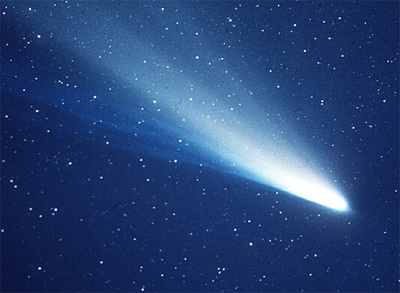
Comets like Halley’s can be a breeding ground for complex molecules such as dipeptides. Comets colliding with Earth could have delivered these molecules and seeded the growth of more complex proteins and sugars necessary for life.
view full UCB Press Release
January 8, 2013 — Earth-size planets common in galaxy
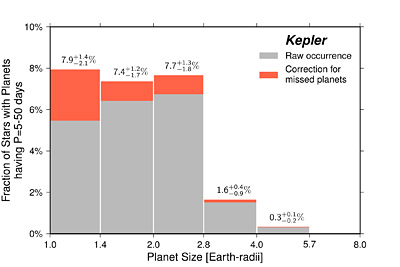
The fraction of Sun-like stars having planets of different sizes, orbiting within 1/4 of the Earth-Sun distance (0.25 AU) of the host star. The graph shows that planets as small as Earth (far left) are relatively common compared to planets 8.0x the size of Earth (similar to Jupiter). The gray indicates the planets discovered in this study, and the orange represents the correction applied to account for planets the TERRA software would miss statistically, typically about 20%.
view full UCB Press Release
December 5, 2012 — Gordon and Betty Moore Foundation Gives a Big Boost to BigBOSS
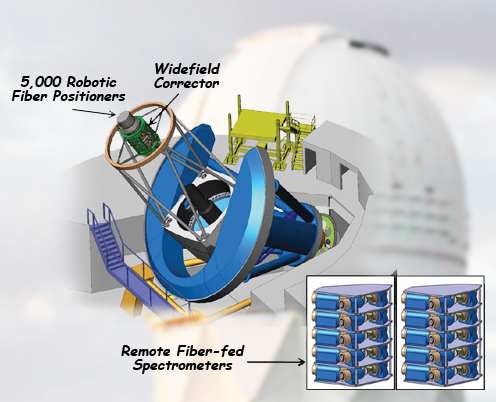
The BigBOSS proposal adds a new widefield, prime-focus corrector to the Mayall 4-meter telescope. A focal array with 5,000 optical fibers, individually positioned by robotic actuators, delivers light to a set of 10 three-arm spectrometers. (Lawrence Berkeley National Laboratory. Background photo Mark Duggan)
A $2.1 million grant from the Gordon and Betty Moore Foundation to the University of California at Berkeley, through the Berkeley Center for Cosmological Physics (BCCP), will fund the development of revolutionary technologies for BigBOSS, a project now in the proposal stage designed to study dark energy with unprecedented precision. BigBOSS is based at the U.S. Department of Energy’s Lawrence Berkeley National Laboratory (Berkeley Lab).
“BigBOSS is the next big thing in cosmology,” says Uroš Seljak, Director of the BCCP, who is a professor of physics and astronomy at UC Berkeley and a member of Berkeley Lab’s Physics Division. “It would map millions and millions of galaxies, allowing us to measure dark energy to high precision – and would yield other important scientific results as well, including determining neutrino mass and the number of neutrino families.”
view full Press Release
October 17, 2012 — Keck observations reveal complex face of Uranus

The two faces of Uranus as seen through the adaptive optics on the near-infrared camera of the Keck II telescope in Hawaii. The white features are high altitude clouds like Earth’s cumulous clouds, while the bright blue-green features are thinner high-altitude clouds akin to cirrus clouds. Reddish tints indicate deeper cloud layers. In each image, the north pole is at the right and is highlighted by small convective spots highly reminiscent of features seen on Saturn’s pole.
The planet Uranus, known since Voyager’s 1986 flyby as a bland, featureless blue-green orb, is beginning to show its face.
By using a new technique with the telescopes of the Keck Observatory, astronomers have created the most richly detailed, highest-resolution images ever taken of the giant ice planet in the near infrared, revealing an incredible array of atmospheric detail and more complex weather.
The planet, in fact, looks like many of the solar system’s other large planets — the gas giants Jupiter and Saturn, and the ice giant Neptune — said Imke de Pater, professor and chair of astronomy at the University of California, Berkeley, and one of the team members. The planet has bands of circulating clouds, massive swirling hurricanes and an unusual swarm of convective features at its north pole.
view full UCB Press Release
October 5, 2012 — Grants help scientists explore boundary between science & science fiction
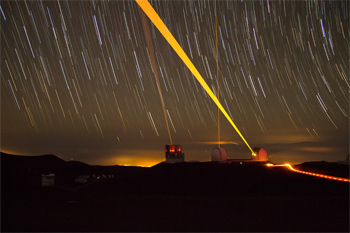
Lasers in use by telescopes atop Mauna Kea in Hawaii. If aliens elsewhere in the galaxy use lasers for astronomy or communications, we may be able to detect them from Earth. Courtesy of Keck Observatory.
Astronomer Geoff Marcy, who kicked off the search for extrasolar planets 20 years ago, plans to rummage through data from the Kepler space telescope in search of evidence for civilizations advanced enough to have built massive orbiting “solar” power stations.
Theoretical physicist Raphael Bousso will look for ways of detecting universes other than our own, and try to understand what these alternate universes, or multiverses, will look like.
Marcy and Bousso are among 20 innovative researchers who will share more than $4 million in New Frontiers in Astronomy & Cosmology International Grants that were announced Thursday, Oct. 4, by the University of Chicago. The grants were made possible through funding from the Pennsylvania-based John Templeton Foundation as a way to encourage scientists and students worldwide to explore fundamental, big questions in astronomy and cosmology that engage groundbreaking ideas on the nature of the universe...
view full UCB Press Release
October 2, 2012 — Panofsky Prize Honors Researchers' Underground Hunt for Dark Matter
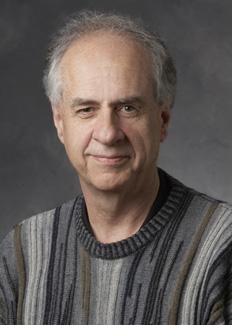
Blas Cabrera, the Stanley G. Wojcicki Professor in the Stanford Physics Department, who has a term appointment at SLAC, is a recipient of the 2013 W.K.H. Panofsky Prize in Experimental Particle... (Photo courtesy Stanford University)
The search for dark matter runs deep with physicists Blas Cabrera and Bernard Sadoulet, who have chased this mystery far underground and will be recognized for their work as joint recipients of the 2013 W.K.H. Panofsky Prize in Experimental Particle Physics. The prize is named for SLAC's founding director, Wolfgang "Pief" Panofsky, and awarded by the American Physical Society.
While some researchers are scanning the heavens with powerful telescopes to detect dark matter or crashing particles together in an effort to create and study its exotic components, Sadoulet, of the University of California, Berkeley, and Lawrence Berkeley National Laboratory, and Cabrera, of Stanford University and SLAC National Accelerator Laboratory, have sought the same answers in deep shafts largely shielded from cosmic rays and other unwanted particle "noise."
Their continuing, decades-long Cryogenic Dark Matter Search has brought them to several underground sites in the hunt for direct evidence of theorized weakly interacting massive particles, or WIMPs. If they are proven to exist, WIMPs could help define and explain dark matter, which is thought to make up about 25 percent of the energy density in the universe and is responsible for the formation of structure in the universe...
view full SLAC Press Release
September 4, 2012 — Explosion of galaxy formation lit up early universe
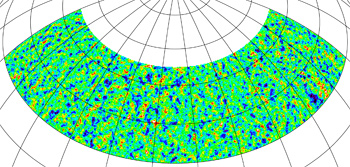
The South Pole Telescope recorded temperature fluctuations in the cosmic microwave background, the light left over from the Big Bang, to study the period of cosmological evolution when the first stars and galaxies formed early in the history of the universe. The image, only a third of which was used for the current analysis, shows variations in millionths of a degree Kelvin. (South Pole Telescope Collaboration)
BERKELEY - New data from the South Pole Telescope indicates that the birth of the first massive galaxies that lit up the early universe was an explosive event, happening faster and ending sooner than suspected.
Extremely bright, active galaxies formed and fully illuminated the universe by the time it was 750 million years old, or about 13 billion years ago, according to Oliver Zahn, a postdoctoral fellow at the Berkeley Center for Cosmological Physics (BCCP) at the University of California, Berkeley, who led the data analysis.
The data provide new constraints on the universe’s first era of galaxy formation, called the Epoch of Reionization. Most astronomers think that early stars came to life in massive gas clouds, generating the first galaxies. The energetic light pumped out by these stars is thought to have ionized the hydrogen gas in and around the galaxies, creating “ionization bubbles” millions of light years across that left a lasting, telltale signature in the cosmic background radiation (CMB). This relic light from the early universe is visible today everywhere in the sky and was first mapped by UC Berkeley physicist and Nobel laureate George Smoot, founder of the BCCP.
August 23, 2012 — Supernovae of the same brightness, cut from vastly different cosmic cloth

The supernova PTF 11kx can be seen as the blue dot on the galaxy. The image was taken when the supernova was near maximum brightness by the Faulkes Telescope North. The system is located approximately 600 million light years away in the constellation Lynx. Image Credit: BJ Fulton (Las Cumbres Observatory Global Telescope Network)
Exploding stars called Type 1a supernova are ideal for measuring cosmic distance because they are bright enough to spot across the Universe and have relatively the same luminosity everywhere. Although astronomers have many theories about the kinds of star systems involved in these explosions (or progenitor systems), no one has ever directly observed one—until now..."
view full LBL press Release
July 24, 2012 — Theoretical astrophysicist receives $500,000+, no strings attached
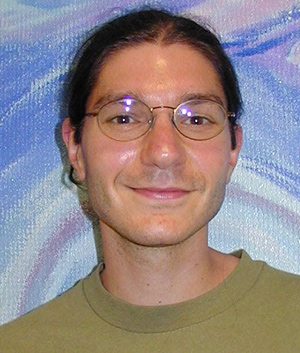
Eliot Quataert, professor of astronomy and physics, has been named a Simons Investigator, one of the first class of 21 announced July 24.
After checking whether the email was a spoof, he accepted.
Offers from the Simons Foundation went out to 21 mathematicians, theoretical physicists and theoretical computer scientists across the country, and the first group of Simons Investigators was announced today (Tuesday, July 24) in a paid ad in The New York Times. The Simons Foundation is a private foundation dedicated to advancing the frontiers of research in mathematics and the basic sciences.
“I have to say that, in my 11 years at Berkeley, this was probably the single most surprising email I have received,” said Quataert, a professor in the departments of astronomy and physics and director of UC Berkeley’s Theoretical Astrophysics Center. “No complaints! What is particularly nice about this grant, from my perspective, is that the Simons Foundation is very flexible in how we can use the funds, which is wonderful because it gives me the opportunity and resources to really explore new research problems, which I like to do.”
As with the MacArthur Foundation “genius awards,” the recipients were unaware they were being considered for the award, and the money comes with no strings attached..."
view full UCB Press Release
April 18, 2012 — Where Do the Highest-Energy Cosmic Rays Come From? Probably Not from Gamma-Ray Bursts

IceCube’s 5,160 digital optical modules are suspended from 86 strings reaching a mile and a half below the surface at the South Pole. Each sphere contains a photomultiplier tube and electronics to capture the faint flashes of muons speeding through the ice, their direction and energy – and thus that of the neutrinos that created them – tracked by multiple detections. At lower left is the processed signal of an energetic muon moving upward through the array, created by a neutrino that traveled all the way through the Earth.
The IceCube neutrino telescope encompasses a cubic kilometer of clear Antarctic ice under the South Pole, a volume seeded with an array of 5,160 sensitive digital optical modules (DOMs) that precisely track the direction and energy of speeding muons, massive cousins of the electron that are created when neutrinos collide with atoms in the ice. The IceCube Collaboration recently announced the results of an exhaustive search for high-energy neutrinos that would likely be produced if the violent extragalactic explosions known as gamma-ray bursts (GRBs) are the source of ultra-high-energy cosmic rays.
“According to a leading model, we would have expected to see 8.4 events corresponding to GRB production of neutrinos in the IceCube data used for this search,” says Spencer Klein of the U.S. Department of Energy’s Lawrence Berkeley National Laboratory (Berkeley Lab), who is a long-time member of the IceCube Collaboration. “We didn’t see any, which indicates that GRBs are not the source of ultra-high-energy cosmic rays.”
view full LBNL Press Release
March 8, 2012 — New discovery is key to understanding neutrino transformations
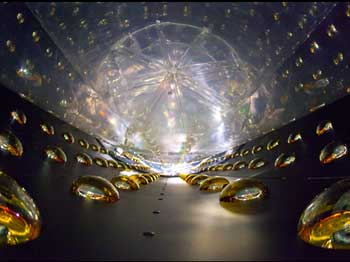
The inside of a cylindrical antineutrino detector before being filled with clear liquid scintillator, which reveals antineutrino interactions by the very faint flashes of light they emit. Sensitive photomultiplier tubes line the detector walls, ready to amplify and record the telltale flashes. (Roy Kaltschmidt photo, LBNL)
BERKELEY - A new discovery provides a crucial key to understanding how neutrinos – ghostly particles with multiple personalities – change identity and may help shed light on why matter exists in the universe.
view UCB Press Release
view LBNL Press Release
January 11, 2012 — Calculating What’s in the Universe from the Biggest Color 3-D Map
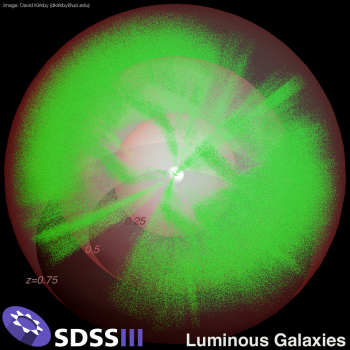
This image shows over a million luminous galaxies at redshifts indicating times when the universe was between seven and eleven billion years old, from which the sample in the current studies was selected. (By David Kirkby of the University of California at Irvine and the SDSS collaboration.)
Since 2000, the three Sloan Digital Sky Surveys (SDSS I, II, III) have surveyed well over a quarter of the night sky and produced the biggest color map of the universe in three dimensions ever. Now scientists at the U.S. Department of Energy’s Lawrence Berkeley National Laboratory (Berkeley Lab) and their SDSS colleagues, working with DOE’s National Energy Research Scientific Computing Center (NERSC) based at Berkeley Lab, have used this visual information for the most accurate calculation yet of how matter clumps together – from a time when the universe was only half its present age until now...
Jan. 3, 2012 — A Stellar Discovery
It takes more than luck to find a supernova. Here’s a look behind the scenes.
On August 24, astrophysicist Peter Nugent was playing a little catch-up. Nugent, an adjunct professor at Berkeley and group leader of the Computational Cosmology Center at Lawrence Berkeley National Laboratory, settled in to look at data collected overnight by the Palomar Transient Factory (PTF). This fully automated survey based at Caltech searches for transients, a catch-all term for as yet unidentified astronomical objects that suddenly appear, change, and fade away.
view UCB Press Release
December 14, 2011 — Closest Type Ia Supernova in Decades Solves a Cosmic Mystery
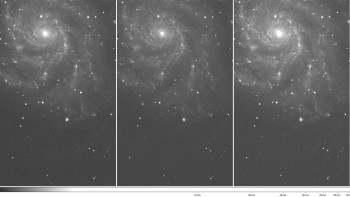
Before and after images of supernova PTF 11kly as it appeared in the nearby M101 galaxy. (Images: Peter Nugent)
Type Ia supernovae (SN Ia’s) are the extraordinarily bright and remarkably similar “standard candles” astronomers use to measure cosmic growth, a technique that in 1998 led to the discovery of dark energy – and 13 years later to a Nobel Prize, “for the discovery of the accelerating expansion of the universe.” The light from thousands of SN Ia’s has been studied, but until now their physics – how they detonate and what the star systems that produce them actually look like before they explode – has been educated guesswork.
December 14, 2011 — Disaster looms for gas cloud falling into Milky Way's central black hole
The normally quiet neighborhood around the massive black hole at the center of our Milky Way Galaxy is being invaded by a gas cloud that is destined in just a few years to be ripped, shredded and largely eaten.
view UCB Press Release
Dec. 13, 2011 — Saul Perlmutter receives Nobel Prize in Stockholm
University of California, Berkeley, and Berkeley Lab physicist Saul Perlmutter was feted in Stockholm, Sweden, last week before receiving his Nobel Prize medal on Saturday, Dec. 10, during a ceremony at the Stockholm Concert Hall.
view UCB Press Release
December 5, 2011 — Record massive black holes discovered lurking in monster galaxies
University of California, Berkeley, astronomers have discovered the largest black holes to date ‑- two monsters with masses equivalent to 10 billion suns that are threatening to consume anything, even light, within a region five times the size of our solar system.
view UCB Press Release
November 2, 2011 — Perlmutter, Filippenko in NOVA special
Newly minted Nobel Laureate Saul Perlmutter and astronomer Alex Filippenko are among the scientists interviewed in the premier episode of a four-part NOVA series, The Fabric of the Cosmos, which airs tonight on PBS stations around the country. In the San Francisco Bay Area, the one-hour episode can be viewed on KQED-TV at 9 p.m.
view UCB Press Release